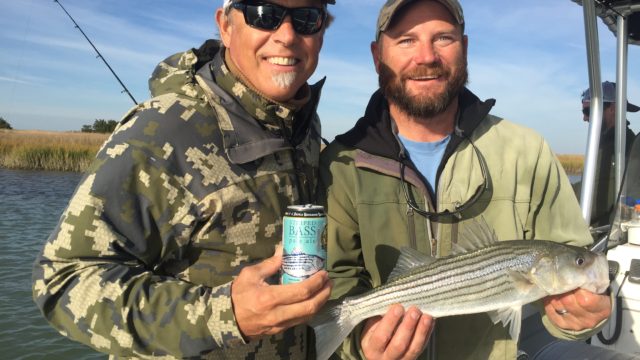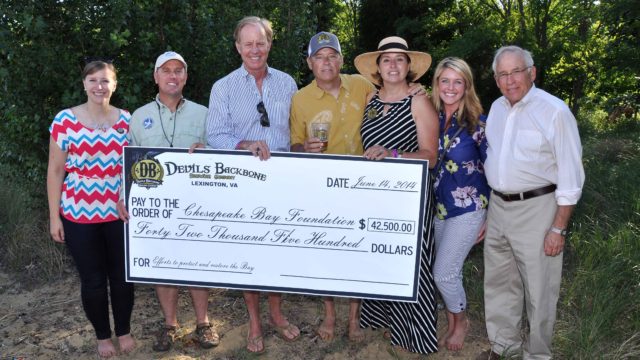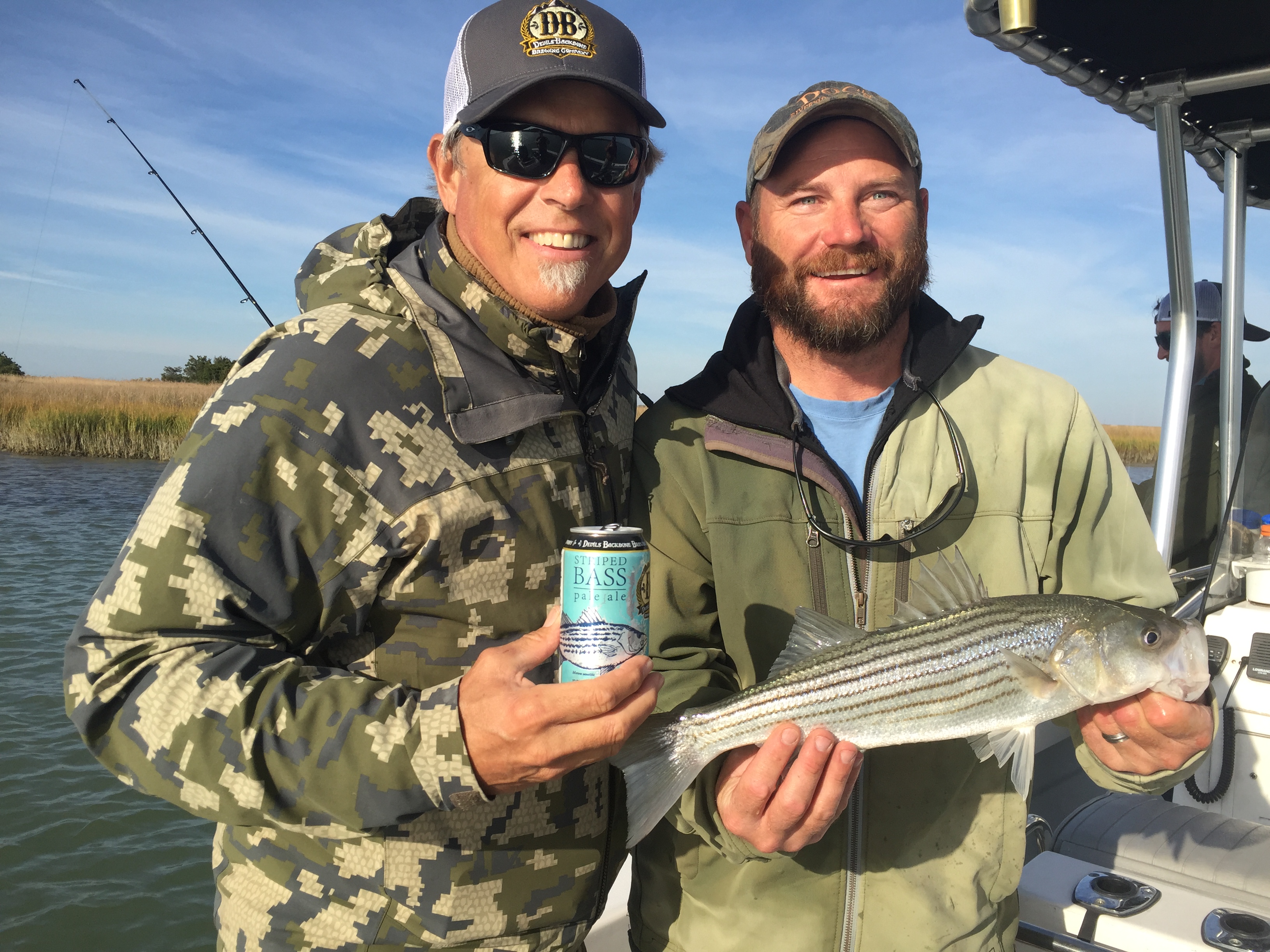
(Steve Crandall, CEO, Devils Backbone Brewing Company with Bart Jaeger, Chesapeake Bay Foundation Discovery Program Manager. Photo courtesy Chesapeake Bay Foundation)
By Jeff Maisey
A friend of mine, Steve Crandall, CEO of Devils Backbone Brewing Company, is certainly passionate about beer, but he’s equally engaged as an outdoorsman.
The restoration and preservation of the Chesapeake Bay is something he and his wife Heidi feel is vital to future generations.
A few years ago, Devils Backbone began production of Stripe Bass Pale Ale as a way to generate funds for the educational work of the Chesapeake Bay Foundation. The Crandalls have raised thousands upon thousands of dollars in the process.
“Since we started the program we have raised over a quarter of a million dollars,” said Crandall.
Interestingly enough, this year marks the 50th Anniversary of the “Save the Bay” campaign. Steve Crandall put me in touch with John Rodenhausen, the Maryland Director of Major Giving, in Annapolis, to see how things are progressing with the Chesapeake Bay. While there have been some positive gains there is still much work to be done.
Here’s my conversation with John Rodenhausen.
The Save the Bay campaign is in its 50th year. Can you take us back to 1966 and describe what the environment was like for the Chesapeake Bay?
The Bay was in a compromised state and getting worse. The founders of the Chesapeake Bay Foundation were a number of businessmen from Baltimore/DC area, and they saw their fishing grounds continually being polluted. So the idea was that we could do something about this.
You had fisheries that were declining; you had water quality that was declining. There was a real opportunity for the private sector to step in and be the watchdog of the region. Now here we are 50 years later.
The Bay probably bottomed out around 1983 as far as water quality goes. Now we’re slowly coming back.
We have a State of the Bay report card we do every two years. We have a new edition that will be coming out this January. We judge 13 different characteristics of the Bay. We look at the nitrogen level; we look at forest buffers; we look at water clarity; we look at dissolved oxygen, oysters, underwater grasses, shad, toxics, resource lands, wetlands, phosphorous, rockfish and blue crabs.
Our score right now is roughly at a 32 out of 100. One hundred being compared to when John Smith and his men first came up the Bay in 1608 and kept really detailed logs about what he saw. Oyster bars that were breaking the surface of the water and fish that were so thick he said he would try to catch them with a frying pan, though it proved to be an unsuitable fishing device.
One hundred would be that pristine Bay John Smith saw, and zero would be completely dead and never coming back.
So we’re at 32, which means the EPA (Environmental Protection Agency) still designates the Chesapeake Bay ecosystem as an impaired body of water, meaning the natural services of the Bay are compromised to the point where they cannot sustain themselves without human intervention.
The hope is that in our short term that we can get that State of the Bay score up to a 40, which would get us off the impaired bodies of water list.
Our long term goal is to get us to a 70 out of 100 score. That’s what we consider a saved Bay. The idea there is that the natural ecosystem can continue to sustain itself without human intervention.
If we’re at a 32 50 years after establishing the Save the Bay initiative that seems rather dire. Was there a grade for the Chesapeake Bay 50 years ago?
We believe 1983 was probably the low point and that was a 23 out of 100, just based on some anecdotal evidence that we saw in some of the science-based record at the time. But I don’t know what the number would have been 50 years ago.
So I’m guessing the Bay declined for almost two decades, between 1966 and 1983, after the Save the Bay campaign was started. Why was that the case?
That’s right.
There was a significant amount of downward pressure on the health of the Bay. Shortly after the Industrial Revolution we started to mechanize all sorts of things. There was massive amounts of industry and development. The Industrial Revolution allowed us to compromise the resources along the waterways more quickly.
The Bay held on for a long time, and then if you watch the health of the Bay it started to fall off this cliff. It was still falling off that cliff when CBF (Chesapeake Bay Foundation) came to be. So it took awhile for us to get the systems, the policies, the education the ecosystem needed in order to start rebounding.
It’s a very large and complicated ecosystem and it takes a lot of upward pressure to finally start to hit that tipping point where you see what you’d call a recovery. We feel like that’s where we are now.
When I started here in the spring of ’98 the score was still pretty low with a report card of around 27.
I understand the negative momentum of going over a cliff before you can right the ship so to speak. Do you have an estimate on the amount of money needed to get the Bay to that 70 grade of self-sustainability?
I’ve seen some estimates that put the Bay recovery costs at somewhere between $20-30 billion.

(Members from the Chesapeake Bay Foundation receive a ceremonial check from Devils Backbone Brewing Company for education and restoration programs.)
What currently are the greatest threats to the Bay’s recovery?
The three biggest pollutants to the Bay are phosphorous, nitrogen and sediment. What happens is you get this negative feedback where you have nutrients and sediment washing off the land after each rainstorm. Once those, basically fertilizers, are suspended in a water column it enables algae to grow. When the algae grows you get this giant bloom that blocks sunlight and keeps sunlight from penetrating down to the bottom and helping the underwater grasses grow. Underwater grasses are important because its where blue crabs and all sorts of fish hide from predators. Having lush underwater grass beds helps filter the water; it provides oxygen to the critters that are in the Bay.
Oysters are doing their best to filter-out all that algae, but there’s this dangerously out of balance system where there’s just too much algae. Once that algae dies what happens is the bacteria move in to break it down. Bacteria use up the dissolved oxygen in the water that is necessary for the life of the crabs, the fish, the oysters.
By simply having too much nitrogen and phosphorous you’ve started this feedback loop where all these other critters are not able to get the oxygen they need to survive.
Critical to the health of the Chesapeake Bay are the rivers and tributaries that feed into it, correct?
That’s right.
Our watershed is 64,000 square miles. It spans six states and the District of Columbia. We go as far north as New York; the watershed starts in the lakes up there – Cooperstown where the Baseball Hall of Fame is. Four hundred and forty-four (444) miles downstream from Cooperstown is where the Susquehanna River meets the Bay. The Susquehanna in particular is important because it gives us about half of the fresh water that comes into the Bay.
We, as an organization, are focusing a lot of our effort making sure Pennsylvania has the right policies in place and is dedicating the funding towards reducing their pollution because it does have a huge impact on the health of the Chesapeake Bay.
The major (negative) impact right now is from agriculture. About 40 to 45% of the nitrogen getting into the Bay is coming from agriculture across the board. Pennsylvania has a big chunk of that.
Is this from family-run farms or large corporate farmland?
Well, after World War II there was a glut of processed nitrogen leftover and they started utilizing it to fertilize our fields; so back to that point of industrializing our practices. Agriculture really took off. They were able to increase yields on smaller pieces of land and they were able to just start pumping more nutrients in.
Once we started doing that it became the norm. What you’re starting to see is a movement over the last 5-10 years where people are encouraged to buy local, buy organic. That does have some pretty profound impacts because if you are not shipping the bulk of your produce from across the country or globe you’re reducing the carbon footprint. But there’s also a lot of nitrogen that comes out of the process as well.
So, yeah, eating local is certainly huge.
Eating meat can have a significant impact because of the drain on resources and the nitrogen and phosphorus produced by raising the animals. You have these concentrated animal feeding operations with thousands of cows or thousands of pigs in a small area. They can overwhelm a local stream or river with all sorts of pollutants.
We ask that people consider their diet and habits.
What are some of the most popular fish species in the Chesapeake Bay for recreational use?
This time of year rockfish are one of the biggest game species around. They are schooling up before they head out for their migration.
You’ve got rockfish, speckled trout, and red drum. They are probably the three biggest apex predators in the Bay that are fun for fishing, but then you’ve got white perch, cobia, yellow perch, croaker and spot – all tasty fish.
Are these fish populations considered healthy?
It depends on the species. They all have different habits and live in different parts of the water column so they’re impacted differently.
Rockfish had nearly collapsed and was on the verge of species extinction in the Bay back in the ‘80s. From 1985 to 1989 there was a moratorium so that nobody could catch rockfish either commercially or recreationally. The population rebounded.
You had this huge population of rockfish but unfortunately the primary forage fish for that — the menhaden – had not seen a similar recovery so all of a sudden you had all these rockfish but not their preferred food.
What we’ve seen in years past is this fish wasting disease called mycobacteriosis. Sometimes you’ll catch these beautiful rockfish but some fish have these lesions on them because they’ve been infected with this mycobacteriosis. The fish can die from that. You’ll see they have really pale looking meat; very soft flesh you can put your finger through. It’s advised if you catch one of these fish that you put it overboard immediately and not touch it with your bare hands.
The Department of Natural Resources has upped the size limit on it. Before you could keep two fish at 18 inches. Now you can only keep rockfish 20 inches and larger. That’s one way of protecting the species.
In Virginia Beach we have a rockfish tournament each year. Do you see such tournaments as an educational opportunity and healthy or is it a treat to the species?
We advocate that people utilize the resources as much as they can within the confines of the regulations. There has been a push towards having catch-and-release tournaments rather than catch-and-kill. By taking a photo of a fish with a pre-designated ruler you don’t have to drag giant fish that are spawning.
A lot of these tournaments happen in the beginning of the year when these fish are spawning.
Devils Backbone Brewing Company CEO Steve Crandall is an avid fisher and hunter. The brewery donates proceeds from the sale of its Striped Bass Pale Ale to the Chesapeake Bay Foundation each year for preservation and restoration. Do you see the use of beer and the artwork associated with the packaging as both a way to generate funding while educating regular people about the Chesapeake Bay?
Yeah, it has been a really great partnership. I was able to meet Steve during a fishing trip. While we were sitting down and enjoying some of the bounty of the Bay he looked at me and said, “You know I really want to brew a beer for you guys,” because he is passionate about it and wants to raise funds for our education and restoration program.
He kind of put the ball in our court. He asked, what should it look like? What should it taste like? What kind of beer should it be for your mission?
We talked about what if you had a can with something crisp and light that would go well while you’re fishing on the water. So they came up with the Striped Bass Pale Ale. It seems to be a really popular beer.
They allowed us to craft some of the messaging on the cans and talk about how “from mountain streams and coastal rivers to the shores of the Chesapeake the water connects us all.”
I think that’s a really good message. If you’re going to have a craft beer you’re going to need good clean water. So this has been a good opportunity to bring people into the fold who are hopefully out fishing and feel connected to the resource, and will feel good about supporting these programs that are helping to reduce pollution, increase fisheries and restore the Bay back to a portion of what it once was.
It’s really important to stress how great the Crandalls have been. They’ve been a driving force in this partnership, and they’re not just checking a box. You can tell conservation is really a part of their DNA. It is important to them that they leave a legacy of clean water and a healthy resource that everyone can enjoy. The fact that they do it with beer makes it all the more fun. Their new motto is “saving the Bay one can at a time.”




